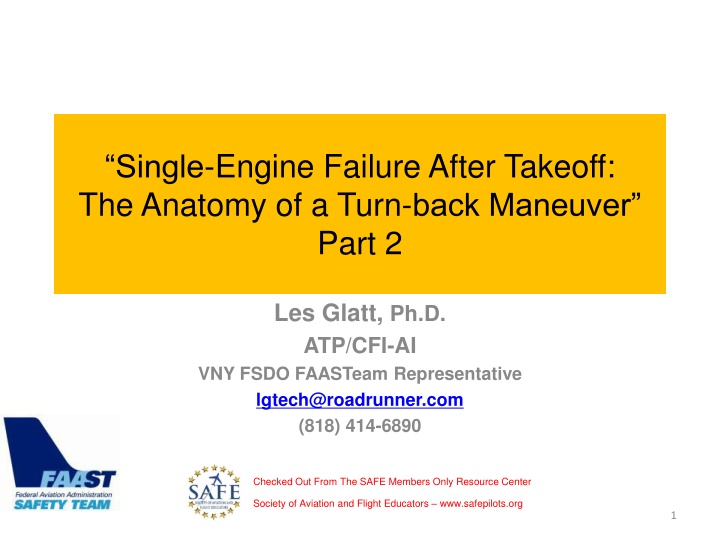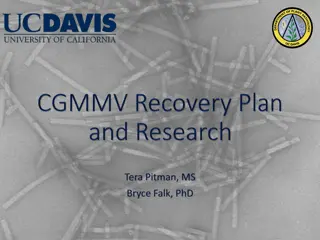Hepatitis C Virus Screening, Testing, and Diagnosis in Adults
This guideline aims to increase compliance with New York State public health law by promoting HCV screening in adults, especially those born between 1945 and 1965. It emphasizes universal testing, including for pregnant individuals, and provides evidence-based recommendations for HCV diagnosis and treatment referral. The New York State Law mandates HCV screening for the specified age group and requires reporting of suspected or confirmed cases to the local health department. Data on newly diagnosed HCV cases in New York State and New York City are also presented.
Download Presentation

Please find below an Image/Link to download the presentation.
The content on the website is provided AS IS for your information and personal use only. It may not be sold, licensed, or shared on other websites without obtaining consent from the author.If you encounter any issues during the download, it is possible that the publisher has removed the file from their server.
You are allowed to download the files provided on this website for personal or commercial use, subject to the condition that they are used lawfully. All files are the property of their respective owners.
The content on the website is provided AS IS for your information and personal use only. It may not be sold, licensed, or shared on other websites without obtaining consent from the author.
E N D
Presentation Transcript
Single-Engine Failure After Takeoff: The Anatomy of a Turn-back Maneuver Part 2 Les Glatt, Ph.D. ATP/CFI-AI VNY FSDO FAASTeam Representative lgtech@roadrunner.com (818) 414-6890 Checked Out From The SAFE Members Only Resource Center Society of Aviation and Flight Educators www.safepilots.org 1
Force Balance During a Steady Gliding Turn is the bank angle Vertical lift component = Component of Weight perpendicular to flight path Horizontal Component of Lift = Centrifugal force V 2 = R Radius of turn - Cos Tan g Rate of turn V = R 3 Q*
Parameters that Characterize a Steady Gliding Turn Airspeed (V) Turn radius (R) Bank angle ( ) Flight path angle ( ) Angle-of-attack ( ) Rate of turn is not necessary since we have included both airspeed and turn radius 4
How Do We Select the Variables for the Turn-back Maneuver? Three relationships exist between the 5 variables Balance of forces along the flight path Balances of forces perpendicular to the flight path Balance of forces in the plane of the turn Two of the variables can be chosen arbitrarily As pilots we can easily observe two of the 5 variables Bank angle (attitude indicator) Airspeed (airspeed indicator) 5
What is the Second Myth of Gliding Flight? While the aircraft is in a gliding turn what bank angle should be utilized to minimize the altitude loss? Shallow- less than 25 degrees Medium- between 25-35 degrees Steep- greater than 35 degrees Is there a limit on how large a bank angle you would use? Answer- There is one bank angle that will minimize the altitude loss in the gliding turn It is between 45 and 46 degrees You Will See Why in the Discussion that Follows 6
What is Glide Path Angle in a Turn? General expression for the glide path angle can be obtained by looking at the balance of forces Along flight path Perpendicular to flight path n = Tan L/D 4 3.5 3 Load Factor V = n (V 1) 2.5 AS S G 2 1 1.5 = n 1 Cos 0.5 0 0 10 20 30 40 50 60 70 Bank Angle 7
How Do We Determine the Altitude Loss in the Turn-back Maneuver? 8
Determining the Altitude Loss in the Turn-back Maneuver Determine the altitude loss in each of the three segments of the turn-back maneuver and add them up Segment 1: Initial Gliding turn Segment 2 : Wings-level glide Segment 3: Final Gliding turn 9
How Do We Determine the Altitude Loss in a Steady Gliding Turn? 10
Determining the Altitude Loss in a Steady Gliding Turn If we know Vertical speed of the aircraft (rate of descent) in feet/sec Rate of turn of the aircraft in degrees/sec Then the altitude loss per degree of turn is just Altitude Loss Vertical Speed = Degree of Turn Rate of Turn Altitude Loss R = Sin V = Vertical Speed Sin Degree of Turn V = Rate of Turn R Altitude loss is just the altitude loss per degree of turn multiplied by the number of degrees the aircraft turns 11
Altitude Loss During Gliding Turns In segments 1 and 3 Altitude loss per degree of heading change F F 1 Altitude loss 3 = Per degree of turn F F 2 4 F1 = Aircraft Weight/Wing Area Wing Loading F2 = Density of the air Density altitude Slight L/D Dependence F3 = Bank Angle Function Controlled by the pilot F4 = CL L/D Aircraft Aerodynamics Controlled by the pilot 12
How Does Aircraft Weight (F1)Effect the Altitude Loss in a Turn-back Maneuver 13
Weight Effect on Altitude Loss in Turn-back Maneuver (F1) Percent Below Gross Weight Percent Reduction in Altitude Loss 0 0 5 5 10 10 15 15 20 20 F F 1 Altitude loss 3 = Per degree of turn F F 2 4 Predicated on appropriate reduction of airspeeds with reduction in weight 14
Airspeed Variation with Reduction in Weight Percent Below Gross Weight Percent Reduction in Airspeed 0 0 5 2.5 10 5.1 15 7.8 20 10.5 Rule of thumb: Reduce airspeed by the percentage below gross weight 15
How Does Density Altitude (F2) Effect the Altitude Loss in the Turn-back Maneuver 16
Density Altitude Effect on Altitude Loss in the Turn-back Maneuver (F2) Density Altitude (feet) Percent Increase in Altitude Loss Sea Level 0 1000 3 2000 6 3000 9 4000 13 5000 16 6000 20 7000 23 8000 27 F F 1 Altitude loss 3 = Per degree of turn F F 2 4 Pressure Altitude and Temperature Density Altitude 17
How Does Aircraft Aerodynamics (F4) Effect the Altitude Loss in the Turn-back Maneuver? 18
Aerodynamic Function F4 for a C-172 14 13 12 11 10 Stall Angle-of-attack 9 8 CL* (L/D) 7 6 5 4 3 2 1 0 0 0.1 0.2 0.3 0.4 F 1 0.5 0.6 0.7 0.8 0.9 CL 1 1.1 1.2 1.3 1.4 1.5 1.6 1.7 1.8 F Altitude loss 3 = Per degree of turn F F 2 4 19
Aerodynamic Function F4 (Cont.) Plot of CL L/D shows that it is a maximum at the accelerated stall speed of the aircraft (for all aircraft) Need to select a margin of safety in the speed for the turn-back maneuver Select a speed of 10 percent above the accelerated stall speed corresponding to whatever bank angle will be used for the turn Operating at this angle-of-attack only gives up 11% additional altitude loss per degree of turn as compared to operating at the accelerated stall speed 20
Variation of CL*L/D versus CL for C-172 14 13 12 11 10 9 8 CL* (L/D) 7 Turn-back Maneuver Flown here 6 5 4 3 2 1 0 0 0.1 0.2 0.3 0.4 0.5 0.6 0.7 0.8 0.9 CL 1 1.1 1.2 1.3 1.4 1.5 1.6 1.7 1.8 Stall Angle-of-attack 21
How Does Bank Angle (F3) Affect the Altitude Loss in the Turn-back Maneuver? 22
Bank Angle Function F3 for C-172 2 F F 1 1.9 Altitude loss 3 = Per degree of turn F F 2 1.8 4 1.7 1.6 1.5 F3 1.4 1.3 F3 is minimum at 45.4 deg 1.2 1.1 1 0.9 15 20 25 30 35 40 45 50 55 60 65 70 75 Bank Angle (deg) 23
How Can We Minimize the Altitude Loss in Segment 1? The term which is a function of bank angle will minimize the altitude loss in segment 1 if the bank angle is between 45 and 46 degrees Depends on the value of L/D 45 degrees at very large values of L/D Load factor at 45 deg bank is 1.41 We satisfy the previous turn-back guideline of Do not bend the aircraft C-172 airspeed would be 65KIAS Advantage of 65 KIAS in a C-172 is that it is the same airspeed used for the wings-level glide speed at gross weight (i.e. entire turn-back maneuver flown at 65 KIAS) 24
Comparison of Flight Characteristics for a 20, 45, and 70 Degree Bank Angle Turn-back Maneuver for C-172 Parameter 20 deg 45 deg 70 deg Load Factor 1.1 * VAS (Kts) Turn Radius Glide Path Angle (deg) Rate of Turn (deg/sec) Rate of Descent (ft/min) F3 Altitude loss ( ft/deg) 25
Comparison of Flight Characteristics for a 20, 45, and 70 Degree Bank Angle Turn-back Maneuver for C-172 Parameter 20 deg 45 deg 70 deg Load Factor 1.06 1.41 2.92 1.1 * VAS (Kts) Turn Radius Glide Path Angle (deg) Rate of Turn (deg/sec) Rate of Descent (ft/min) F3 Altitude loss ( ft/deg) 26
Comparison of Flight Characteristics for a 20, 45, and 70 Degree Bank Angle Turn-back Maneuver for C-172 Parameter 20 deg 45 deg 70 deg Load Factor 1.06 1.41 2.92 1.1 * VAS (Kts) Turn Radius 56.5 65.0 91.5 Glide Path Angle (deg) Rate of Turn (deg/sec) Rate of Descent (ft/min) F3 Altitude loss ( ft/deg) 27
Comparison of Flight Characteristics for a 20, 45, and 70 Degree Bank Angle Turn-back Maneuver for C-172 Parameter 20 deg 45 deg 70 deg Load Factor 1.06 1.41 2.92 1.1 * VAS (Kts) Turn Radius 56.5 65.0 91.5 784 384 285.4 Glide Path Angle (deg) Rate of Turn (deg/sec) Rate of Descent (ft/min) F3 Altitude loss ( ft/deg) 28
Comparison of Flight Characteristics for a 20, 45, and 70 Degree Bank Angle Turn-back Maneuver for C-172 Parameter 20 deg 45 deg 70 deg Load Factor 1.06 1.41 2.92 1.1 * VAS (Kts) Turn Radius 56.5 65.0 91.5 784 384 285.4 Glide Path Angle (deg) 7.1 9.3 18.8 Rate of Turn (deg/sec) Rate of Descent (ft/min) F3 Altitude loss ( ft/deg) 29
Comparison of Flight Characteristics for a 20, 45, and 70 Degree Bank Angle Turn-back Maneuver for C-172 Parameter 20 deg 45 deg 70 deg Load Factor 1.06 1.41 2.92 1.1 * VAS (Kts) Turn Radius 56.5 65.0 91.5 784 384 285.4 Glide Path Angle (deg) 7.1 9.3 18.8 Rate of Turn (deg/sec) 7.0 16.5 31.0 Rate of Descent (ft/min) F3 Altitude loss ( ft/deg) 30
Comparison of Flight Characteristics for a 20, 45, and 70 Degree Bank Angle Turn-back Maneuver for C-172 Parameter 20 deg 45 deg 70 deg Load Factor 1.06 1.41 2.92 1.1 * VAS (Kts) Turn Radius 56.5 65.0 91.5 784 384 285.4 Glide Path Angle (deg) 7.1 9.3 18.8 Rate of Turn (deg/sec) 7.0 16.5 31.0 Rate of Descent (ft/min) 706 1088 2985 F3 Altitude loss ( ft/deg) 31
Comparison of Flight Characteristics for a 20, 45, and 70 Degree Bank Angle Turn-back Maneuver for C-172 Parameter 20 deg 45 deg 70 deg Load Factor 1.06 1.41 2.92 1.1 * VAS (Kts) Turn Radius 56.5 65.0 91.5 784 384 285.4 Glide Path Angle (deg) 7.1 9.3 18.8 Rate of Turn (deg/sec) 7.0 16.5 31.0 Rate of Descent (ft/min) 706 1088 2985 F3 1.54 0.99 1.47 Altitude loss ( ft/deg) 32
Comparison of Flight Characteristics for a 20, 45, and 70 Degree Bank Angle Turn-back Maneuver for C-172 Parameter 20 deg 45 deg 70 deg Load Factor 1.06 1.41 2.92 1.1 * VAS (Kts) Turn Radius 56.5 65.0 91.5 784 384 285.4 Glide Path Angle (deg) 7.1 9.3 18.8 Rate of Turn (deg/sec) 7.0 16.5 31.0 Rate of Descent (ft/min) 706 1088 2985 F3 1.54 0.99 1.47 Altitude loss ( ft/deg) 1.68 1.08 1.60 33
Bank Angle Limitation in Segment 3 Without power the aircraft cannot accelerate to higher speed to achieve the increased bank angle necessary to reduce the turn radius without a critical loss in altitude Need to fly at V2 in segment 3 Segment 3 bank angle is limited to insure the aircraft does not stall at V2 Maximum bank angle in segment 3 corresponds to the load factor V ( 0.83 n = Includes the 1.1 safety Factor on VAS 2) 2 V S_1g 34
How Do We Create a Chart of Altitude Loss Versus Distance from the DER for a Turn-back Maneuver? 35
Criteria Used to Create a Table of Altitude Loss Versus Distance from the DER Sum the altitude loss in each of the 3 segments Segment 1: Initial turn Bank angle 45 degrees V1 = 1.1 * VAS (10 % above accelerated stall speed) Segment 2: Wings-level glide V2 = VMaxL/D Segment 3: Final turn V3 = VmaxL/D Bank angle 15 degrees 36
C-172 Aircraft Selected to for the Turn-back Maneuver 37
Flight Parameters for C-172 for the 3 Segments (Gross Weight at Sea Level, No Wind) Segment 1 Bank angle 45 degrees Airspeed 65 KIAS (10% above accelerated stall speed) Radius of turn 384 feet Altitude loss 1.08 ft/deg Rate of descent -1088 ft/min Segment 2 Bank angle 0 degrees Airspeed 65 KIAS Rate of descent 723 ft/min Segment 3 Bank angle 15 degrees Airspeed 65 KIAS Radius of turn 1415 feet Altitude loss 2.8 ft/deg Rate of descent 746 ft/min 38
Total Altitude Loss for Turn-back Maneuver for C-172 (Gross Weight, Sea Level, No Wind) 1000 900 Total Altitude Loss for Turn-back (ft) 800 700 Regionof impossible turn-back 600 500 400 300 Segment 3 Constraint - 15 deg bank angle 200 100 0 0 500 1000 1500 2000 2500 3000 3500 4000 4500 5000 5500 6000 6500 7000 Distance from DER (ft) 39
C-172 Runway Intercept Angle (No Wind Case) 60 50 Runway Intercept Angle (deg) 40 30 Regionof Impossible Turn-back 20 10 0 0 1000 2000 3000 4000 5000 6000 7000 Distance from DER (ft) 40 *
Altitude Loss in Each Segment Versus Distance from DER for C-172 (Gross Weight, Sea Level, No Wind) 800 700 Region of Impossible Turn 600 Segment 2 Altitude Loss (ft) 500 400 300 Segment 1 200 Segment 3 100 0 0 1000 2000 3000 4000 5000 6000 7000 Distance from DER (ft) 41
Unusable Runway Length for 15 degree Bank in Segment 3 (Gross Weight, Sea Level, No Wind) 1600 1400 1200 Unusable Runway (ft) 1000 800 600 400 200 0 0 10 20 30 40 50 60 70 80 90 Runway Intercept Angle (deg) 42
Risk Reduction Chart of altitude loss during the turn-back maneuver versus distance from DER does not provide useful information to the pilot prior to departure Pilot would need to monitor altitude versus distance from DER after take-off Need to be able to make a determination prior to take-off if the turn-back maneuver falls in the envelope of the Impossible-Turn-back region Need a different type of chart for decision making 44























